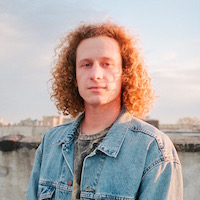More about Nevadaville
- All
- Info
- Shop

Contributor
It’d be pretty easy to argue that circuses and clowns are sadder than Nevadaville, CO; at least in a “your entire childhood is a sham” kind of way.
And while the ghost town has many circus-like attributes (e.g. empty buildings, stray dogs, cheap drugs), it lacks the delirious fun of truly upsetting places. Probably that’s why everybody died and left.
Obviously Kuniyoshi wasn’t painting Nevadaville for posterity, he was painting it because it was (and likely still is) a very depressing little town. He did this painting in 1942, the year that executive order 9066 forced 275,000 Japanese-Americans into internment camps and that some of his neighbors in Woodstock, NY threatened to ‘tar and feather’ him. Generally Kuniyoshi was committed to being a fun guy, but he admitted that during this period his art held “implications of many sad things.”
And if you’re trying to make art about sadness, Nevadaville seems like a good place to start. It was considered a ghost town when Kuniyoshi painted this, but at least a few of the ghosts weren’t dead yet which is simultaneously awkward and embarrassing; it’s pretty hard to mess that up like oh you meant dead dead, I thought we were going for more of a brain-dead type of thing, my bad. It’s a gold mining town with no gold, a ghost town that still has living residents but nobody to share 5 cent cigars with. Every Coloradan you meet will boast about the 300 days of sunshine they get every year, but not here. And isn’t there a sense that the buildings are threatening to slide completely off of the canvas, leaving just a dry landscape from northern Colorado with no so-called American nation to speak of?
Nevadaville then is less of a landscape and more of a very accurate portrait of Kuniyoshi’s year – he could have been equally factual by spray painting the word “bummer” over every inch of blank wall America has to offer.
Sources
- Colorado State Planning Commission. Colorado: A Guide to the Highest State. New York: Hastings House, 1948. Accessed September 19, 2017. https://books.google.com/books ?id=EBmv2pnmNyIC&pg=PA265&lpg=PA265&dq=nevadaville+1940+population&source=bl&ots=NpDnm
- Documents from the National Archives: Internment of Japanese Americans. Dubuque, Iowa: Kendall/Hunt Publishing Co., 1989. Accessed September 14, 2017. https://www.our documents.gov/doc.php?flash=false&doc=74
- Stamberg, Susan. August 13, 2015. “The Anxious Art Of Japanese Painter (and ‘Enemy Alien’) Yasuo Kuniyoshi.” NPR The Morning Edition. Accessed September 7, 2017. Http: //www.npr.org/2015/08/13/430374356/the-anxious-art-of-japanese-painter-an…-
- Wolf, Tom. “Yasuo Kuniyoshi.” New York: Whitney Museum of American Art at Philip Morris, 1986. Accessed September 14, 2017. https://archive.org/stream/yasuokuniyos hi00kuni/yasuokuniyoshi00kuni_djvu.txt












